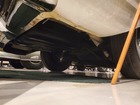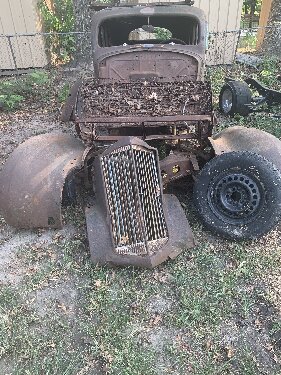|
120 dual master cylinder
|
||||
|---|---|---|---|---|
|
Home away from home
|
Thinking of converting my master cylinder to a dual in my 36 120.
What is the best and easiest conversion I could pursue? W
Posted on: 2017/12/26 13:57
|
|||
|
||||
|
Re: 120 dual master cylinder
|
||||
|---|---|---|---|---|
|
Forum Ambassador
|
In addition to a master with the ports either universal on each side or at least on the exposed side, in most cases you will also need some kind of bracket to adapt the bolt holes from the frame or plate holding the old cylinder to match the new cylinder mount. I believe most of the old single masters Packard used bolt from the side thru the body of the master while most of the duals mount from the end. Here is one such bracket made for the conversion applied in a later model car.https://packardinfo.com/xoops/html/modules/newbb/viewtopic.php?post_id=171631#forumpost171631
If the bracket or the new cylinder combination offsets the push rod appreciably from a straight 90 degree angle between the brake pedal pivot attachment and cylinder piston you will also need to make some kind of adjustment there. On some pedals it is possible to reverse the rod to the other side of the pivot and on others it requires a new relocated pivot bracket.
Posted on: 2017/12/26 15:28
|
|||
|
Howard
|
||||
|
||||
|
Re: 120 dual master cylinder
|
||||
|---|---|---|---|---|
|
Home away from home
|
Not looking to change my brakes. Someone told that a duel master cylinder does not affect points at a show, I already have turn signals and seat belts but the rest I want as original and as safe for daily driving
Thanks for your input W
Posted on: 2017/12/26 15:34
|
|||
|
||||
|
Re: 120 dual master cylinder
|
||||
|---|---|---|---|---|
|
Forum Ambassador

|
I believe all antique car club venues that judge will not deduct for directional signals or seat belts if installed in a workmanlike manner. If your modification of the brake system is visible, I believe it will result in a judgint deduction in most venues.
You can go to the AACA forum which has a special place for judging questions and ask the specific question. Likewise you can review the Packard Club judging criteria in their Directory, and also ask their chief judge for an opinion.
Posted on: 2017/12/26 17:10
|
|||
|
||||
|
Re: 120 dual master cylinder
|
||||
|---|---|---|---|---|
|
Home away from home
|
I submit that if you did a statistical risk assessment, that adding adding a dual master cylinder has no appreciable benefit to the safety of the car if the car is not operated on salty corrosive streets. A far vaster improvement in safety is achieved if all of the steel lines are replaced and the hoses changed. In another 40 years change all of the steel lines again. I am a bit of an emphatic crank that NO Packard should still be equipped with its original brake tubing.
I hold this view based on observations: In 45 years with old cars I have never seen a brake hose fail by bursting. Stopped up, yes, perhaps 3 times. Burst, no. I have seen any number of burst and weeping brake tubes in the same period. They corroded externally, usually from salt, and internally by means of ancient brake fluid. So if the system is brought up to snuff the only likely cause of sudden failure is road debris cutting a line. Unlikely. Now lets turn to the dual cylinder. It needs a long stroke from the pushrod in the event of a line failure. Better make sure your 36 can provide a stroke long enough to operate the brakes served by the undamaged half of the system. If they are not in good adjustment they will not be applied. My friend found this out when a line burst from corrosion on a 10 year old pickup. There was no response to the pedal. Dual cylinder conversions are very popular with the Studebaker crowd. But if I open any one of the bleeder screws I have no brakes. Hmmmm. All of this to say the most beneficial thing for any Packard is to be retubed, and probably with that copper nickel tubing. It is a dream to work with. After that keep the brakes in good adjustment and change the brake fluid from time to time.
Posted on: 2017/12/26 18:02
|
|||
|
||||
|
Re: 120 dual master cylinder
|
||||
|---|---|---|---|---|
|
Forum Ambassador

|
Fully agreee, Ross.
And the more I read of posts like this, the more I love the vacuum boosted mechanical brakes on my 1934 Eight.
Posted on: 2017/12/26 18:28
|
|||
|
||||
|
Re: 120 dual master cylinder
|
||||
|---|---|---|---|---|
|
Home away from home

|
I agree with Ross's post above. The Tandem system is much to do about very little. Unless u plan to convert to disk which is nothing but much to do about nothing.
Maybe a POWER brake conversion with single cylinder would be more benficial but would most likely reuire a brake pedal change relo the power brake to the firewall in someway.
Posted on: 2017/12/26 18:29
|
|||
|
VAPOR LOCK demystified: See paragraph SEVEN of PMCC documentaion as listed in post #11 of the following thread:f
https://packardinfo.com/xoops/html/modules/newbb/viewtopic.php?topic_id=7245 |
||||
|
||||
|
Re: 120 dual master cylinder
|
||||
|---|---|---|---|---|
|
Forum Ambassador
|
Quote:
Dual cylinder conversions are very popular with the Studebaker crowd. But if I open any one of the bleeder screws I have no brakes. Hmmmm. Is this due to the longer stroke needed before the second piston travels far enough to apply or something else? Almost sounds like racing type parallel independent single masters -- one for the front and the other for the rear would be a better approach except I don't think you can get those with power boosters.
Posted on: 2017/12/26 18:54
|
|||
|
Howard
|
||||
|
||||
|
Re: 120 dual master cylinder
|
||||
|---|---|---|---|---|
|
Home away from home
|
Yes, when one half of dual system develops a leak, one or the other of the two pistons within the cylinder must go to the very end of its travel before pressure is developed behind the other piston. If, say, tubing at the rear of the car fails: The front piston must move all the way to the end of the bore and stop before the piston behind it begins to create some pressure for the front brakes. If the front brakes with their relatively large cylinders are somewhat out of adjustment, you will need a looong push before pressure is built up. In a factory system that is taken into account as well as possible, but if not properly designed the pedal will be to the floor before that rear piston has brought the shoes out to the drums. In which case the dual cylinder was a fool's paradise.
More simply stated, the stroke of the pushrod must be sufficient to bottom both pistons.
Posted on: 2017/12/26 21:27
|
|||
|
||||








